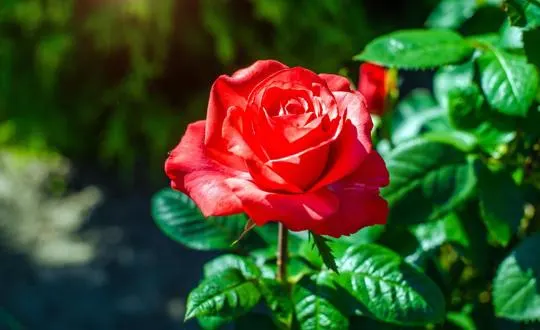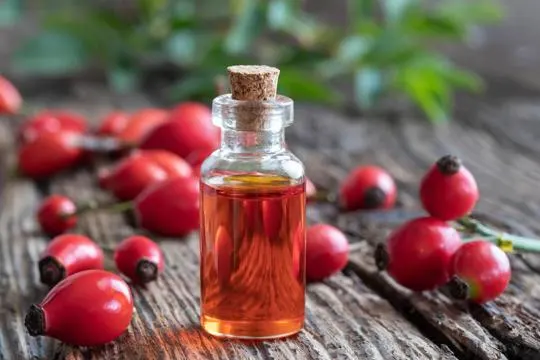Summary of key points
The main difference between rosehip and rose lies in their uses and parts of the plant they come from. Rosehip is the fruit of a rose plant, while rose refers to the flower.
Rosehips are known for their high levels of vitamin C and are often used in herbal teas, jams, and supplements. On the other hand, roses have been cultivated for their beauty and are often used in perfumes, skincare products, and decorations.
In terms of flavor, rosehips have a tart and slightly sweet taste while roses have a subtle floral flavor. Both offer unique benefits and can be enjoyed in different ways.
Rosehip and rose aren’t the same beast. One’s a fruit, the other’s a flower. Simple, right? We’ve all admired roses, symbols of love and beauty. Yet, how many of us give a second look to those round, red fruits they leave behind?
Rosehips, those afterthoughts of blooming glory, pack a punch in vitamins. We’re talking more Vitamin C than oranges here. They’re nutrition powerhouses, hidden in plain sight.
Now, us? We’ve been guilty of overlooking them. Thinking, “It’s just a rose’s accessory.” Couldn’t have been more wrong.
Rosehips tell a story, far beyond the bouquet.
What are Rosehips?

Rosehips are vibrant fruits that form from wild roses after petals drop.
They are appreciated for their high vitamin C and traditional medicinal uses.
Rosehips have a slightly sweet, tangy flavor, often used in teas, jams, jellies, and skincare.
What sets rosehips apart from roses? Not just their looks and smell – they also contain vitamins A, E, K, antioxidants, and essential fatty acids.
This makes them helpful for immunity, skin health, and reducing inflammation.
Rosehips are found all over the world, and usually harvested after the first frost when ripe.
Use them fresh or dried. Rosehips are rich in polyphenols, which can aid digestion, reduce joint pain, and support heart health.
Enjoy them as a tea, infused oil, powder, smoothie, or baked goods.
What is a Rose Flower?

Roses are a captivating natural creation. With their velvety petals and sweet scent, they symbolize love, passion, and beauty.
Roses come in many colors – from bright reds to gentle pinks and pure whites.
They are often used in bouquets and arrangements to add elegance to any event.
These flowers have been cultivated for centuries, with different species from around the world.
The most well-known is the hybrid tea rose, with its large blooms and long stems.
Other varieties include the floribunda rose, with its clusters of smaller blooms, and the grandiflora rose, with traits from both hybrid teas and floribundas.
Not only are roses admired for their beauty, but also valued for their medicinal properties.
Rose petals, leaves, and hips are used in traditional medicine.
Rosehip oil, from wild roses, is full of vitamins A, C, and E, making it a helpful ingredient in skincare products.
Roses hold deep symbolic meanings in many cultures.
They often represent love, romance, and passion.
In some societies, a single red rose is seen as a sign of deep affection.
Roses bring joy and beauty – that’s for sure.
Differences Between Rosehips and Roses

Roses and rosehips may sound alike, but they are two completely different plants.
Roses are popular for their beauty and aroma. But, rosehips offer more than that.
Roses are grown for their appealing looks and smell.
They come in many shapes and colors and can make any garden look beautiful.
But, apart from their visual appeal, they don’t have much to offer.
Rosehips, on the other hand, provide plenty of perks.
They are the fruit that form after the petals of a rose fall off.
They may not be as attractive, but they are packed with nutrition.
Rosehips are full of Vitamin C and antioxidants, which are good for the immune system and reduce inflammation.
Rosehips also taste great. They can add tartness and flavor to jams, jellies, teas, and syrups.
Plus, they can be used as a gelling agent to thicken recipes. So, don’t be fooled by their looks.
Rosehips are powerful fruits with plenty of health and culinary benefits.
Don’t miss out on these gems from nature’s garden.
Origin and Plant Part
Rosehip and rose have different origins. Rosehips are the fruits of wild or cultivated rose plants.
These fruits can be round or oval, and come in red, orange, or black.
They contain seeds and are often used to make jams, jellies, teas, and skincare products.
Roses, on the other hand, are the flowers.
They come in many colors, sizes, and shapes.
People have been growing them for centuries due to their beauty and scent.
To sum up, rosehips and roses come from the same species.
Rosehips are the edible fruits, while roses refer to the flowers that are admired for their beauty.
Usage and Applications
Rosehip and rose are two distinct botanical products.
They both have beauty and health benefits, but they offer unique qualities.
Rosehip is derived from the fruit of the wild rose plant.
It is packed with vitamins, antioxidants, and essential fatty acids.
This makes it great for skincare. Rosehip oil can be used in facial serums, moisturizers, and anti-aging products.
Rosehip tea is known for its immune-boosting effects and anti-inflammatory properties.
Roses are cultivated for their beauty and fragrance.
They are used in floral arrangements and perfumes.
Rose petals can be dried to create potpourri or used in culinary creations.
Rosewater is made by distilling rose petals with water.
It is a natural toner and flavoring agent. Rosehip and roses have different applications.
Roses have visual appeal, fragrance, and culinary uses.
Rosehip focuses on its regenerative properties for skincare products.
Both botanicals contribute to beauty routines and sensory experiences in creative ways.
Nutritional Value and Health Benefits
Rosehip and rose are two distinct plants with their own unique nutritional value and health benefits.
Rosehips provide a rich source of vitamin C, antioxidants, and essential fatty acids.
These nutrients make them great for boosting immunity, promoting healthy skin, aiding digestion, and reducing inflammation.
Rosehips are also used as a natural remedy for arthritis, colds, and respiratory issues.
Roses, however, are known more for their ornamental beauty.
Though, certain species like Rosa rugosa can be consumed and offer health benefits.
Their petals have a calming effect on the nervous system.
As well as, they possess antibacterial properties to keep the body healthy.
It’s important to note that both rosehips and roses have their own advantages.
They can be used together in various forms.
Such as, herbal teas or skincare products.
Combining them creates a potent blend that nourishes the body and enhances overall well-being.
Flavor Profile and Aroma
Rosehip and rose tantalize with their flavors and fragrances.
Rosehip has a tart, sweet taste with a hint of floral.
Roses, however, have a delicate, perfumed flavor.
Rosehip has a tangy twang plus berry undertones.
Roses evoke a dreamy, romantic garden atmosphere.
Rosehip adds depth to teas and jams.
Roses are perfect for confectioneries and cocktails.
For vibrant tang or elegant allure, rosehip and roses have something special.
Similarities Between Rosehips and Roses

Rosehips and roses have lots in common despite their differences.
Both are derived from the Rosa canina plant.
They both smell wonderful and are used in many industries.
Plus, they both look amazing with vibrant colors that can brighten any space.
These shared traits make them popular and useful.
The similarity that stands out is that they are both from the same plant species.
Rosehips are the fruit and roses are the flowers on the same bush.
This unites them through their botanical background.
Another link is their scents which have mesmerized people for centuries.
The aroma from rosehips and roses makes lovely perfumes and air fresheners.
Plus, they both have properties that make them excellent for various industries.
Rosehip oil has a lot of vitamins A and C and is great for skin care.
Also, roses’ essential oil is used in perfumery, soaps, and skincare products.
Lastly, they have stunning colors that bring life to any area.
Reds, pinks, yellows, and whites radiate from both rosehips and roses.
Gardens, floral arrangements, or any other setting are made more beautiful by these hues.
Culinary and Medicinal Uses of Rosehips and Roses
Culinary and Medicinal Uses of Rosehips and Roses:
Rosehips and roses have many uses in the culinary and medicinal realms.
In cooking, rosehips bring a tangy taste to jams, jellies, and teas.
Plus, they are filled with vitamin C, making them a popular pick for health drinks and herbal supplements.
Roses, meanwhile, are often added to desserts for their delightful fragrance.
From rosewater to rose petal jam, these flowers give sweet treats a special touch.
Rosehips and roses are also beneficial for health.
Rosehips have anti-inflammatory properties, which may help ease joint pain and increase immune function.
Plus, they are abundant in antioxidants, which may help reduce the risk of heart disease.
Roses, meanwhile, can be used in aromatherapy to bring a sense of calmness and uplift moods.
Applied topically, roses can nourish skin too.
More noteworthy facts include rosehips’ role in treating scurvy during World War II, and certain varieties of roses, such as Rosa damascena, being highly valued in perfumery for their unique scent.
Both rosehips and roses offer a wide range of culinary and medicinal benefits.
Whether you’re cooking or looking for healing, these plants can be a great addition to your daily life.
Choosing Between Rosehips and Roses for Different Purposes
Rosehips and roses have unique traits.
Rosehips are rich in vitamins and antioxidants, so they’re used in health and beauty products.
Roses are valued for their beauty and fragrance and often used in flower arrangements and perfumes.
Consider these factors when deciding which to use.
Rosehips are popular in skincare and wellness products.
They have anti-inflammatory qualities that soothe skin and promote youthfulness.
Plus, their antioxidants make them great for anti-aging skincare.
So, if you want to reduce acne scars or improve skin tone, rosehip-based products can help.
Roses are appreciated mainly for their beauty.
They express emotions and their scent is captured in perfumes and oils.
Plus, they look great in bridal bouquets, centerpieces, and gifts.
Rosehips and roses don’t have to be mutually exclusive.
Many beauty products combine both for a great experience.
Floral arrangements often include both roses and rosehips for texture and visual impact.
Conclusion
Summing up, rosehip and rose are different. Rosehip is the fruit of rose plants.
While roses are the flowering plants. Each has its own uses and benefits.
Rosehips are full of vitamins, mainly vitamin C.
People use them to make herbal teas and skincare products.
They are anti-inflammatory and may help with boosting the immune system.
Roses are admired for their beauty and fragrance.
Different colors and varieties, each with its own scent.
People use roses in floral arrangements and perfumes.
Roses also have symbolic meanings.
Red roses signify love, and yellow roses are symbols of friendship and joy.

Leave a comment